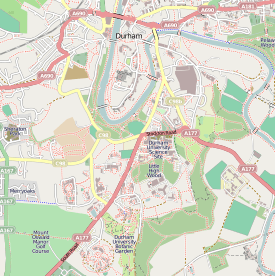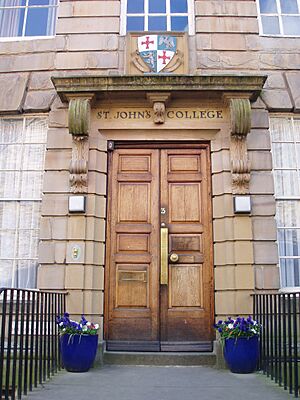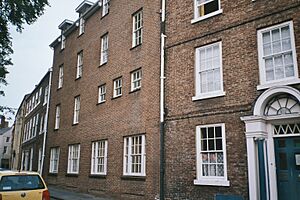St John's College, Durham facts for kids
Quick facts for kids St John's College |
||||||||||||||||
|---|---|---|---|---|---|---|---|---|---|---|---|---|---|---|---|---|
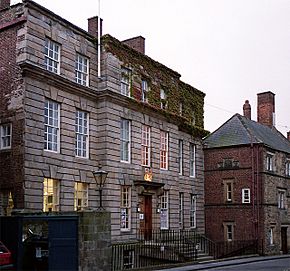
Haughton House, St John's College
|
||||||||||||||||
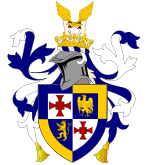
Arms of St John's College
Blazon: Quarterly argent and azure, in the first and fourth a cross formy quadrate gules, in the second·an eagle wings elevated and inverted Or, in the third a lion rampant crowned with an ancient crown of the last; all within a bordure quarterly of the second and gold. |
||||||||||||||||
|
|
||||||||||||||||
| University | University of Durham | |||||||||||||||
| Coordinates | 54°46′19″N 1°34′33″W / 54.7718825°N 1.5757305°W | |||||||||||||||
| Latin name | Collegium Sancti Ioannis | |||||||||||||||
| Motto | Latin: Fides nostra victoria | |||||||||||||||
| Motto in English | Our faith is our victory | |||||||||||||||
| Established | 1909 | |||||||||||||||
| Namesake | St John the Evangelist | |||||||||||||||
| Principal | Jolyon Mitchell | |||||||||||||||
| Warden | Nicholas Moore | |||||||||||||||
| Undergraduates | 392 | |||||||||||||||
| Postgraduates | 160 | |||||||||||||||
| Senior tutor | Rebecca Bouveng | |||||||||||||||
| Mascot | Olav III (an alligator) | |||||||||||||||
| Website |
|
|||||||||||||||
| Map | ||||||||||||||||
St John's College is one of the colleges at Durham University. It started in 1909 as a special college for people studying to become priests in the Church of England. By 1919, it became a full part of the university.
The college has two main parts: John's Hall, for all students, and Cranmer Hall. Cranmer Hall is a college for training priests in the Anglican Church. All Durham students who study theology automatically become members of St John's. The college first accepted only men, but later became mixed, training men and women together.
St John's is the second smallest college at Durham. It is an independent college, meaning it manages its own money and rules. This gives it more freedom than other colleges. However, the university must approve its principal (the head of the college).
The college is known for its religious background. It is the only college in Durham that can train people for priesthood. St John's also has many old traditions. Students have their own special ceremony in their 12th-century chapel. They also wear special robes for weekly formal dinners and say grace in Latin. St John's is the only college in Durham that does not charge students for laundry. It also makes attending formal dinners free. The college chapel, called Church of St Mary the Less, is where Dame Elizabeth Bowes is buried. She was an ancestor of the Queen Elizabeth The Queen Mother.
Contents
College History
St John's College was founded in 1909. It began as a college for training priests in the Church of England. In 1919, it officially became a full part of Durham University.
In 1958, the college split into two parts. Cranmer Hall continued to train priests. John's Hall was created for students studying other university subjects. Both parts have always followed a broadly evangelical Christian tradition.
St John's was the first male college at Durham to accept female students in 1973. Cranmer Hall had already been training women for priesthood since 1966. St John's was also the first Church of England theological college to have a lay person (someone not a priest) and a woman as its principal, Ruth Etchells.
College Buildings
The college is made up of several old Georgian houses. These houses are located on the Bailey street, between Durham Cathedral and the River Wear. The main building is Haughton House. It is named after Haughton Castle, which belonged to the family of William Donaldson Cruddas. His family helped fund the college and other Christian charities.
The houses that make up Cranmer Hall used to belong to the Bowes-Lyon family. This was the family of the late Queen Elizabeth The Queen Mother. Most of the college buildings are Grade II listed. This means they are important historical buildings. Parts of 3 and 4 South Bailey are even more important, being Grade II* listed.
Before St John's owned it, Linton House (No. 1 South Bailey) was the main building for St. Chad's College. It is believed to be very old. Its front was added after the king returned to power in 1660.
No. 2 South Bailey has special round "blind" windows. These were found when the building was repaired in the 1980s. This helped experts figure out the building was built in the late 1600s.
Many of the college buildings are connected in confusing ways. Visitors often get lost inside. Some stairways are also unusual, with one seeming to disappear into a wall. This makes the architecture feel a bit like an Escher drawing.
The college chapel is called St Mary the Less. It is very old, dating back to Norman times. It was rebuilt in the 1840s and updated around 2000. It became the college chapel in 1919. Before that, it was a local church for the South Bailey area. The chapel is also used by the local Greek Orthodox church.
Student Life
Because St John's is a small college, students tend to know each other well. This is true no matter their year, course, or where they live. All first-year students and most final-year students live in the college. Second-year students usually find their own housing outside.
Elected student representatives help new students feel welcome. They provide more one-on-one help in the first few weeks. This can be a better start than in larger colleges.
St John's students enjoy many sports. These include cross country running, mixed lacrosse, rowing, men's football, badminton, hockey, and rugby. The St John's College Boat Club started in 1910. It uses two boathouses on the River Wear.
The college also has a theatre company called Bailey Theatre Company. It is open to any student at the university. In 2019, they worked with St. Chad's to perform "Family Circles." The cast and crew were all first-year students.
Other plays they have performed include 4.48 Psychosis and The Crucible. The company also puts on a Shakespeare play every summer after exams. This is usually performed outdoors on Library Lawn. In 2019, they used the college's new amphitheatre. In 2008, their play Doctor Faustus won an award for Best Play.
John's Music Society started in 2012. It organizes music events in the college. It helps students create new music groups. The society also plans social events and trips to concerts. They are also in charge of popular open mic nights and an annual barbecue.
List of Principals
- 1909–1911 Sidney Nowell Rostron
- 1911–1919 Dawson Dawson-Walker
- 1919–1945 Charles Steel Wallis
- 1945–1953 Ronald Williams
- 1954–1955 G.J. Cumming (acting)
- 1954–1969 Jim P. Hickinbotham
- 1970–1978 John C. P. Cockerton
- 1978–1988 Ruth Etchells
- 1988–1992 Anthony Thiselton
- 1992–1999 David V. Day
- 1999–2006 Stephen Sykes
- 2006–2023 David Wilkinson
- 2023–present Jolyon Mitchell
Famous Former Students
From John's Hall
- Richard Adams – helped start fair trade and founded Traidcraft
- Norman Aspin – a top diplomat for the UK in Malta
- James Bell – a bishop
- Richard Blackburn – a bishop
- Mark Bryant – a bishop
- Douglas Davies – a theologian (someone who studies religion)
- Gavin Hewitt – a special reporter for BBC News
- Ben Howlett – a politician who was a Member of Parliament
- Andrew Macrae (judge) – a high-ranking judge in Hong Kong
- Alice Oseman – a famous author (known for Heartstopper)
- Jack Plumley – a professor of Egyptology at Cambridge
- Nick Ramsay – a politician in Wales
- Rachel Schofield – a journalist and presenter for BBC News
From Cranmer Hall
From Both Halls
- Michael Beasley – a bishop
- Chris Edmondson – a former bishop
- Robert Paterson – a former bishop
- Geoff Pearson – a bishop
- John Saxbee – a former bishop
- Richard Turnbull – a principal of another college
- Justin Welby – the Archbishop of Canterbury (the leader of the Church of England)
Images for kids


